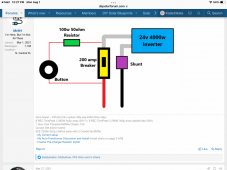Katie33kate
New Member
- Joined
- Jun 26, 2022
- Messages
- 42
I have just replaced my lithium batteries with BestGo 400amp 12v.
it has been a struggle. The first battery had a bad cell and the alarms were ringing at 14.0 v
the replacement battery was at 2.3v. when installed. Vendor claims my inverter/charger cause a massive, instant drain. ??? Honestly doubt it as the inverter/charger was not even on. But, if this is a possible problem source I need to understand it before the next replacement battery shows Up.
has anyone heard of such a thing? I haven’t gotten any detail answer to my questions…the manufacturer is in China and it takes weeks for a simple question to get an answer…then it is followed by more weeks for the next question. I won’t buy this again.
but, meanwhile I am still dealing with battery issues.
can anyone tell me if they have any info about this??
it has been a struggle. The first battery had a bad cell and the alarms were ringing at 14.0 v
the replacement battery was at 2.3v. when installed. Vendor claims my inverter/charger cause a massive, instant drain. ??? Honestly doubt it as the inverter/charger was not even on. But, if this is a possible problem source I need to understand it before the next replacement battery shows Up.
has anyone heard of such a thing? I haven’t gotten any detail answer to my questions…the manufacturer is in China and it takes weeks for a simple question to get an answer…then it is followed by more weeks for the next question. I won’t buy this again.
but, meanwhile I am still dealing with battery issues.
can anyone tell me if they have any info about this??




